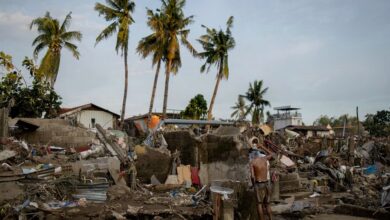
(CNN) – Tropical Storm Alex formed early Sunday after bringing heavy rain and flooding to South Florida a day prior, becoming the first named storm of this year’s Atlantic hurricane season.
Alex was moving away from the Bahamas and toward Bermuda Sunday morning with sustained winds of 50 mph. Monday, the storm expected to pass pass north of Bermuda, which is currently under tropical storm warning. Gusty winds and 2 to 3 inches of rain are possible.
“Some slight strengthening is possible today (Sunday) followed by weakening beginning on Monday,” the National Hurricane Center said.
As of early Sunday, the US and the Bahamas were no longer threatened by the storm.
On Saturday, the system hit South Florida with a trio of heavy rain, strong winds and flooding, with up to 11 inches falling in some areas since Friday.
The city of Miami cautioned residents Saturday afternoon that several roads were not accessible. At least one beach was temporarily closed.
Miami-Dade Fire Rescue officials warned the danger of flooding throughout the weekend is “high” across the county, especially in low-lying and poorly drained parts, and urged residents not to try and walk or drive through flooded waters. About 100 vehicles became stranded in floodwaters throughout Miami Friday into Saturday, Fire Chief Joseph Zahralban told CNN affiliate WSVN.
The storm dumped record daily rainfall for June 4 in West Palm Beach (which saw 4.5 inches of water), Fort Lauderdale (which saw 6.55 inches) and Miami (which recorded 5.24 inches), according to the National Weather Service.
Another above-average hurricane season forecast
Just last month, the National Oceanic and Atmospheric Administration issued its forecast for this hurricane season.
It is forecasting an above-average year, with 14 to 21 named storms, six to 10 hurricanes and three to six major hurricanes — of Category 3 strength or greater.
There are several contributing factors that play into a “busy” hurricane season.
“We are in an active period,” said NOAA Administrator Rick Spinrad. “There are certain ingredients that drive the intensity and the frequency of hurricanes.”
One is the existing La Niña conditions in the equatorial Pacific.
This phenomenon creates cooler-than-average ocean temperatures around the equator in the Pacific and results in weather impacts around the globe.
La Niña presents favorable conditions for hurricanes in the Atlantic — in contrast to that of El Niño.
On Thursday, Colorado State University issued an update to its forecast. It now calls for a well-above hurricane season with 20 named storms, 10 hurricanes and 5 major hurricanes.
This is the highest number of named storms CSU has ever forecast for the season in June, Phil Klotzbach, author of the forecast, told CNN. In 2020, the university’s forecast center predicted 19 storms during its June release, but that number included three storms that were named before the season started.
CNN’s Gene Norman contributed to this report.




